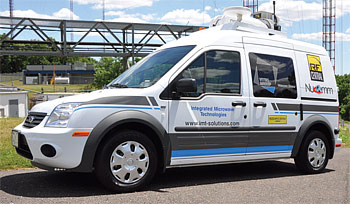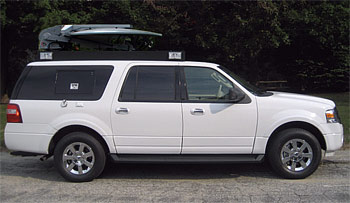Smaller, Lighter, Yet More Powerful
OTTAWA
Now that the DTV studio conversion is history for most U.S. TV news departments, some of them are turning to upgrading their ENG/SNG vans and trucks to HD.
Granted, it's a slow process: "I'd estimate that only 10-20 percent of all U.S. news operations have gone to full HD," said Steve Williamson, director of sales with ENG/SNG vehicle builder Frontline Communications in Clearwater, Fla. "But we are seeing more stations either coming in for new digital ENG/SNG vehicles, or upgrading their existing platforms to be DTV-compatible. So although the changeover is taking time, it is taking place."

Integrated Microwave Technologies' MMRP As these upgrades occur, many stations are taking advantage of lighter, smaller new technology—some of it obtained via the recently completed BAS transition—to reduce the size of their ENG/SNG vehicles. "We are seeing a lot of stations moving from full-size vans and trucks to small SUVs like the Ford Escape, or small vans like the Euro-styled Ford Transit," Williamson says. "These units cost less to buy and to run—and today's generation of DTV ENG/SNG equipment is small enough to work in these environments."
LESS HEIGHT AND POWER
Historically, analog microwave trucks required masts 42-feet or taller. Since it's impractical to drive around with such masts extended, vans had to be big enough to contain telescoping antenna masts inside the cargo bay. They also had to have payload capacity and electrical power to raise/lower the mast, plus drive the watt-hungry gear that went with them.
The move to COFDM microwave has vastly reduced the need for direct line-of-sight transmission paths between trucks and their receive sites. Transmission powers have also dropped, allowing Integrated Microwave Technologies (IMT)—a Vitec Group-owned company formerly known as RF Extreme—to come up with a smaller digital microwave package called the MMRP (Module Mobile RF Platform).
"MMRP lets you do digital microwave transmission using the Ford Transit's existing 8-foot height supplemented by a collapsible 7-foot mast," said Keith Blaisdell, IMT's vice president of product development. "This height reduction allows for a smaller, much lighter RF system, yet one that still has a full pan and tilt high gain antenna on top." The MMRP is also much easier on vehicle power. In fact, all it requires is an 1,800 watt inverter—and there is still enough room to install a dual path microwave link if need be, or an optional SNG satellite link/antenna as well.
INTEGRATED IN ONE PACKAGE
In the old days, ENG/SNG A/V routers came in separate packages; each requiring their own frames. In contrast, the Miranda Technologies' Nvision 8500 hybrid router combines and integrates video and audio routing into the same frame. Not only does this cut space requirements in half, but also eliminates A/V timing issues.
"By having the units combined, we are able to remove steps from the demux/mux chain," said Marcos Lopez, senior vice president, Interfacing, Monitoring and Control for Miranda Technology. "This change removes the latency issue that has long dogged DTV audio signals. But it also cuts the size and weight demands of this equipment in half, and reduces its power requirements as well. This makes these units fit easily into smaller ENG/SNG platforms."
WIDE RANGE OF INPUTS
In the analog past, ENG/SNG trucks only had to cope with NTSC inputs. But now that DTV has arrived, such trucks must be able to handle a range of SD and HD video feeds, and accept footage shot by citizens on iPhones as well as a stunning array of digital cameras ranging in video quality from mediocre to broadcast.

AMT Expedition To cope with all these inputs, Evertz has developed the 1RU HD2014 video processor/converter. "The HD2014 can handle four separate video inputs at a time, each coming from a different format of source device," says Mo Goyal, Evertz's manager of product marketing. "Each of the input channels come with full frame synchronization, up/down/cross conversion, noise reduction, video processing and video enhancement capabilities." Evertz also makes a two input version (HD2012) and one channel version (HD2011).
ONE BUTTON CONNECTABILITY
SNG communications can be a real challenge. Antennas are large and cumbersome, and locking them onto the right satellite can stymie an experienced engineer.
In response to this reality, ENG/SNG truck integrator Accelerated Media Technologies (AMT) in Auburn, Mass., has started installing Commtact MOST (Mobile Satellite Terminals) on its smaller ENG/SNG vehicles. "The MOST's antenna is a 10-inch tall, 36-inch wide enclosed dome that sits on top of the vehicle," said AMT President Thomas Jennings. "It is a self-tracking unit that stays connected to whatever satellite you specify, and that can move up to 3 Mbps of data, which is enough for MPEG4 real-time video."
Because the MOST automatically tracks its satellite connection even when in motion, going to air is easy. "It's a one button push that anyone can perform," Jennings says. "As well, the system can be used as an IP hub. This means the reporter can grab their WiFi equipped camcorder, lock the vehicle and walk away, secure in the knowledge that their feed is getting back to the station."
As stations look to cost-effectively upgrade their ENG/SNG systems, many vendors are providing products that can be purchased for SD mode, and then upgraded painlessly to HD with the purchase of a software "key."
"Upgrading makes good economic sense," says Frontline's Williamson. "It's also the best way to stay competitive with your neighboring stations; many of which have or are about to ramp up to full HD."
The professional video industry's #1 source for news, trends and product and tech information. Sign up below.
James Careless is an award-winning journalist who has written for TV Technology since the 1990s. He has covered HDTV from the days of the six competing HDTV formats that led to the 1993 Grand Alliance, and onwards through ATSC 3.0 and OTT. He also writes for Radio World, along with other publications in aerospace, defense, public safety, streaming media, plus the amusement park industry for something different.

